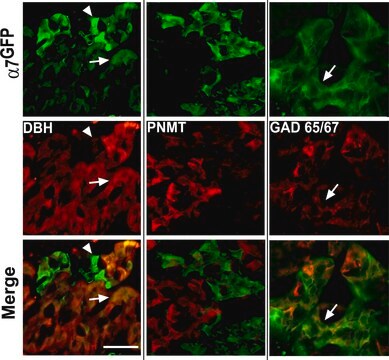AB1787P
Anti-Dopamine D4 Receptor Antibody, extracellular domain
Chemicon®, from rabbit
About This Item
Produtos recomendados
fonte biológica
rabbit
Nível de qualidade
forma do anticorpo
affinity purified immunoglobulin
tipo de produto de anticorpo
primary antibodies
clone
polyclonal
purificado por
affinity chromatography
reatividade de espécies
mouse
fabricante/nome comercial
Chemicon®
técnica(s)
ELISA: suitable
western blot: suitable
nº de adesão NCBI
nº de adesão UniProt
Condições de expedição
dry ice
modificação pós-traducional do alvo
unmodified
Informações sobre genes
mouse ... Drd4(13491)
Especificidade
SPECIES REACTIVITIES: The immunogen peptide shows sequence homology of 90% with rat and human D4 receptors (Van Tol et al. 1992; Legerski & Peterson 1992; Livingstone et al. 1992; Seeman et al. 1994; O′Malley et al. 1992). Antibody cross-reactivity with D4R from various species is not known.
Imunogênio
Aplicação
Neuroscience
Neurotransmitters & Receptors
ELISA: 0.5-1.0 μg/mL (1 μg/mL immunogen peptide/well)
Not tested in immunohistochemical methods.
Optimal working dilutions must be determined by the end user.
Ligação
forma física
Armazenamento e estabilidade
Outras notas
Informações legais
Exoneração de responsabilidade
Não está encontrando o produto certo?
Experimente o nosso Ferramenta de seleção de produtos.
Código de classe de armazenamento
10 - Combustible liquids
Classe de risco de água (WGK)
WGK 2
Ponto de fulgor (°F)
Not applicable
Ponto de fulgor (°C)
Not applicable
Certificados de análise (COA)
Busque Certificados de análise (COA) digitando o Número do Lote do produto. Os números de lote e remessa podem ser encontrados no rótulo de um produto após a palavra “Lot” ou “Batch”.
Já possui este produto?
Encontre a documentação dos produtos que você adquiriu recentemente na biblioteca de documentos.
Nossa equipe de cientistas tem experiência em todas as áreas de pesquisa, incluindo Life Sciences, ciência de materiais, síntese química, cromatografia, química analítica e muitas outras.
Entre em contato com a assistência técnica